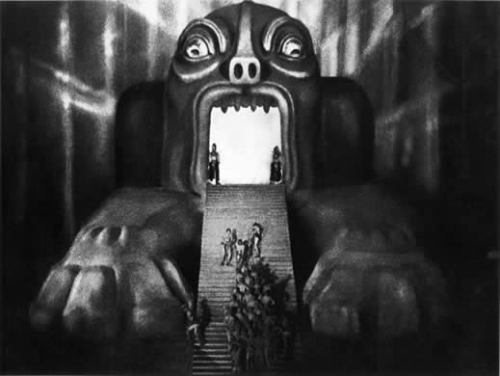Fig 1. Metropolis poster.
Perhaps the easiest way to describe Metropolis to a contemporary viewer would be ‘like Avatar, but with Marxism instead of white guilt’. Perhaps best (and most deservingly) remembered for its glorious set design, Metropolis creates a dystopian cityscape with the sleek angles of expressionism, turning them from heralds of a wonderful future to dismal tools of the oppressors.
The underground scenes are dark and reminiscent of the less pleasant elements of Dickensian London, while above ground all is light and high technology. The film uses this distinction to highlight its very socialist message; the importance of striking a balance between the ‘heads’ (those who conceptualise grand ideas) ‘hands’ (who construct said grand ideas) is a key theme of the film. In addition, the balance between humanity and technology is discussed; clearly the machinery makes the lives of the upper classes above ground comfortable and opulent, but at what cost? “The geometric patterns formed by buildings and workers alike vividly shows how the two are meshed symbiotically in this future hell.” (Cannon, 1997).
Alan Diment captures the film’s visuals perfectly; “The towering cityscapes and huge sets shown in the film are a marvel. What the film might have lacked in available technology it more than makes up for in imagination and wonder. “ (Diment, 2010). The comparatively low-tech sets and effects may seem off-putting, but actually make the film all the more impressive. With 25,000 extras and clever mirror-work to incorporate real actors into miniature sets, Metropolis spares no expense in creating a glorious spectacle.
The film’s message of mutual understanding between workers and employers (‘the mediator between the head and the hands must be the heart’) is resonant even today, and though Lang later admitted that the message was a gross oversimplification, the film nevertheless is still uncannily relevant. While a setting such as Metropolis and the Depths in which the workers are held has not yet come to pass, as a metaphor for capitalism the sets are unmistakable.
The film uses biblical imagery extensively, from the Tower of Babel to the Whore of Babylon. This spirituality hammers home the message of tolerance and kindness to those beneath you even further, “drawing on religious imagery and inspiration in advocating non-violent reconciliation between classes” (Greydanus, unknown), and yet does not feel at all out of place. With a machine in the guise of the workers’ saint becoming the embodiment of the seven deadly sins, it looks at how easily one can fall to decadence, and the retelling of the Tower of Babel as not a tale of divine retribution but the breakdown of relations between employer and employee is, yet again, very Marxist indeed. Even the real workers’ saint, Maria, rescuing children left behind as the workers’ city floods courtesy of their parents’ bloodlust is evocative of the story of Noah’s ark.
Illustration List
Lang, F. (1927). Figure 1. Metropolis poster. https://blogger.googleusercontent.com/img/b/R29vZ2xl/AVvXsEiAPYwtlts0rIHV7gbiQ-NDPtG7bKE4XHoGsceoaUxiMBNj4c2YpF1nPBz-IWaD0Dj72OzUs7oivgqr_3yh493RMhY3657H9f4eInDZbN8PL5xDfE-ySkTDJfcbLuYzZj_OcHNd9kY7oKQ/s1600/metropolis.jpg (Accessed on 27/10/11)
Lang, F. (1927). Figure 2. City still. http://michaelgloversmith.files.wordpress.com/2010/11/metropolis1.jpg (Accessed on 27/10/11)
Lang, F. (1927). Figure 3. ‘Moloch’ still. http://24.media.tumblr.com/tumblr_l9xrhbLZRD1qzf61po1_r1_500.jpg (Accessed on 27/10/11)
Bibliography
Cannon, b. (1997). Film.u-net.com. http://www.film.u-net.com/Movies/Reviews/Metropolis.html (Accessed on 27/10/11)
Diment, A. (2010). Hackney Hive. http://www.hackneyhive.co.uk/index/2010/09/film-review-metropolis/ (Accessed on 27/10/11)
Greydanus, S. (unknown). Decent Films Guide. http://www.decentfilms.com/reviews/metropolis1927.html (Accessed on 27/10/11)




Perhaps the easiest way to describe Metropolis to a contemporary viewer would be ‘like Avatar, but with Marxism instead of white guilt’...
ReplyDeleteWhite guilt - this is such a succinct description of Avatar! Love it!
Great review that makes light work of Marxism, religious imagery, expressionism etc. - a perfect candidate for your written assignment perhaps because of the clear messaging via production design...